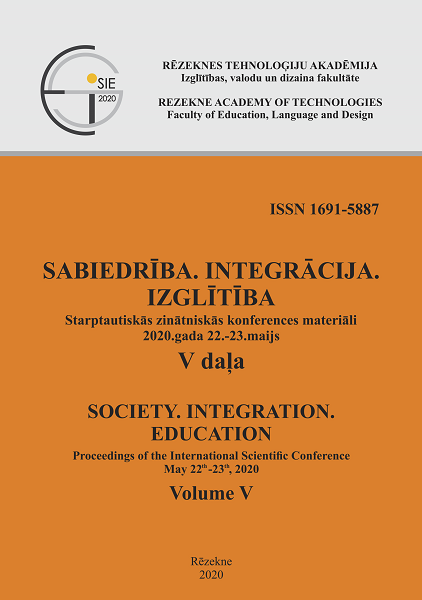METAPHOR ANALYSIS OF TEACHERS’ ROLES IN THE LESS COMMONLY TAUGHT EUROPEAN LANGUAGES PROGRAMS IN CHINA
DOI:
https://doi.org/10.17770/sie2020vol5.5137Keywords:
educational management, LCTELs, metaphor analysis, teachers’ roleAbstract
Teachers’ individual understanding of the roles in their own profession influences the construction of teacher-student and other work relationships. It is also an important indicator for language program managers to perceive the teaching and learning process. Metaphor analysis is an effective method to raise awareness and reflection of professional roles among teachers. This study employs the open-ended questionnaire to investigate the professional roles of the teachers in the Less Commonly Taught European Languages (LCTELs) programs in China. The framework provided by De Guerrero and Villamil’s research is adapted to design and conduct the questionnaire. The elicited metaphors are collected, categorized and analysed, to answer the research questions: (1) How do the participants metaphorically conceptualize themselves as a LCTELs teacher? (2) Is their perception of roles consistent with the results generated in the previous researches about EFL/ESL practice? (3) Are teachers’ actual and expected professional roles identical? The final 38 collected metaphors were classified into 9 categories. The results either proved the metaphors of some traditional teaching roles in the previous researches, or presented the new ones which rooted in the unique practice of the LCTELs programs.
Downloads
References
Asmali, M., & Celik, H. (2017). EFL teachers’ conceptualization of their roles through metaphor analysis. Journal of Language and Linguistic Studies, 13(2), 1-13.
Cameron, L. (1999). Operationalising “metaphor” for applied linguistic research. In Cameron, L., & Low, G. (Ed.), Researching and applying metaphor (3-28). Cambridge: Cambridge University Press.
Dong, X. (2016). The problems of Lesser-Used European Languages Education in China and some relevant advice. Journal of Language Planning, (2), 68-75.
Fabian, G. (2013). The application of improved metaphor analysis in education research. Procedia – Social and Behavioral Sciences, 93(2013), 1025-1029.
Guerrero, M.C.M. de., & Villamil, O.S. (2000). Exploring ESL Teachers’ Roles through Metaphor Analysis. TESOL Quarterly, 34(2), 341-351.
Guerrero, M.C.M. de., & Villamil, O.S. (2002). Metaphorical conceptualizations of ESL teaching and learning. Language Teaching Research, 6(2), 95-120.
Herron, C. (1982). Foreign-Language Learning Approaches as Metaphor. The Modern Language Journal, 66(3), 235-242.
Lakoff, G. (1993). The contemporary theory of metaphor. In A. Ortony (Ed.), Metaphor and thought (4-50). Cambridge: Cambridge University Press.
Lakoff, G., & Johnson, M. (1980). Conceptual Metaphor in Everyday Language. The Journal of Philosophy, 77(8), 453-487.
Lakoff, G., & Johnson, M. (1980). The Metaphorical Structure of the Human Conceptual System. Cognitive Science, 4(2), 195-208.
Lin, W., Shein, P., & Yang, Shu. (2012). Exploring personal EFL teaching metaphors in pre-service teacher education. English Teaching: Practice and Critique, 11(1), 183-199.
Liu, Y. (2010). Professional identities of college English teachers through metaphor analysis. Foreign Languages and Their Teaching, 3(252), 35-39.
Munby, H. (1986). Metaphor in the thinking of teachers: an exploratory study. Journal of Curriculum Studies, 18(2), 197-209.
Wan, W., Low, G. D., & Li, M. (2011). From students’ and teachers’ perspectives: Metaphor analysis of beliefs about EFL teachers’ roles. System, 39(2011), 403-415.
Zhang, X. (2016). Examining English Language Teachers through Metaphorical Analysis. Theory and Practice in Language Studies, 6(8), 1659-1664.


